    
Die LECOULTRES
The LECOULTRES

In alphabetischer Reihenfolge:
Ami Lecoultre
Brechet
C[harles] A[ntoine] Lecoultre (Sohn von Jacques David Lecoultre)
C[harles], Antoine Lecoultre
C[harles] Lecoultre
Jacques-DAVID Lecoultre
D. Lecoultre & fils, Brassus
DAVID Lecoultre & Son
C. Lecoultre
Constant Lecoultre
Dupperut, Aline

Jacques David Lecoultre (Vater
von C[arles] A[ntoine] Lecoultre)
F. C. Lecoultre
Eugen Lecoultre
François Louis Lecoultre (main entry)
François Louis Lecoultre (cross reference)
Gallay, Jean
Golay, Julie
Golay & Lecoultre N° 5476
H. Lecoultre
Henri Lecoultre

Jules Lecoultre
Lecoultre, Charles Antoine
LB (Lecoultre Brothers)
Lecoultre Frères (LF)
Lecoultre Frères (Constant, Eugène und Jules Lecoultre, St. Croix)
Lecoultre-Sublet

From François Charles Lecoultre to Charles François Lecoultre (1865–1871)

Lecoultre & Brechet
Lecoultre & Falconnet
Lecoultre & Granger
Perrelet
Ulysse Lecoultre
Several of the numerous Lecoultres worked in Geneva and flourished from 1821/1822 (Henri Joseph L.) until 1871 (LF) when one was taken over by A. Perrelet who is said but not known to have been a maker.
Other Lecoultres may have continued Geneva production up to the mid 1880s. (Bulleid, Technology, p. 2)
H. Lecoultre = Henri Joseph Lecoultre, 1821/1822–1840
siehe den nächsten Eintrag
Henri Joseph Lecoultre, 1792 – 1856,
1821/1822 –1840
Lecoultre, Henri Joseph
"60 rue Rousseau, Geneva, and, in 1836, at 137 rue Montbrillant, Geneva. Born 23 May 1792, in Le Chenit, Vaud, son of Abraham-Joseph Lecoultre. Died October 1856. Settled in Geneva in 1822, where he was the first to make revolver boxes. Brother of François, he was principal builder of musical boxes in Geneva. He was also the first maker to produce a box with interchangeable cylinders and cylinders which could be fitted to other similar boxes. A movement bearing this name stamped on the comb and contained in a painted wooden case is in the Harding collection. Was in partnership with Granger."
(Ord-Hume, Music Box, 1980, p. 314)

Siehe auch eine Spieldose der SAS-Auktion von 30. Nov. 2011
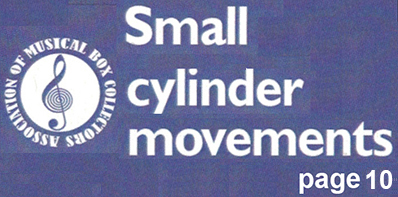

Werknummern: 1– ~3000
Siehe H. Lecoultre
Golay et Lecoultre, um 1822/1830

Known serial: 5476
Henri Joseph Lecoultre & Jean François Granger, 1840–1844
Lecoultre & Granger.
The partnership between Henri Lecoultre (1792-1856) and Jean François Granger (1801-44) lasted between 1840 and the death of Granger in December 1844. The address was quai des Bergues 27, Geneva.
(Ord-Hume, Music Box, 1980, p. 314)
Jean François Granger starb / died in 1844.

Serial not known
Henri Joseph Lecoultre & [Aline] Duperrut, 1841–1852

Werknummern: ~3000–~5000
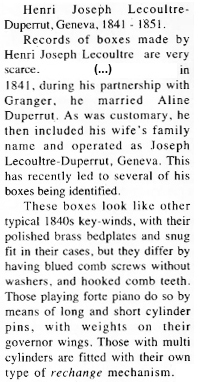
Lecoultre-Duperrut, Joseph
214 Saint Gervais, Sq., Geneva.
After death of his second wife, Henri Joseph Lecopultre married Aline Duperrut in 1841 and used the joint names. Aline died June 1851.
(Ord-Hume, Music Box, 1980, p. 314)
N° 4522 (D. Bachelard et Fils)
Zu den Abbildungen der Spieldosen von Henri Joseph Lecoultre & [Aline] Duperrut
1847: Hooked teeth
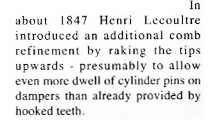
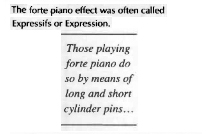

Weitere Info siehe in dem Artikel der Zeitschrift TMB wie oben angegeben (online nachlesbar).
1852 zog sich Henri Joseph Lecoultre zurück, letzte Werknummern dürften um die 5000 gewesen sein (TMB 21, 3, 2003, S. 1010)

Weitere Angaben
Lecoultre-Sublet, 1852–1870
(Napoleon III. war ebenfalls in den Jahren 1852–1870 Kaiser von Frankreich)
Lecoultre-Sublet betrieb ein Spieldosengeschäft in St. Croix.
“The Lecoultre-Sublet company was very active for about twenty years. Its founder was probably a Lecoultre from the Vallée de Joux who settled in Sainte-Croix, hoping to find a favorable climate for the manufacture of music boxes, as was the case for Eugène Lecoultre in 1890.
Paris World Exhibition 1855
This enterprise can be tracked as far back as 1852 and, in the following years, on the occasion of national and international exhibitions. For his first participation in an exhibition, Lecoultre-Sublet obtained an honorable mention for his “music boxes of excellent harmony” in Paris in 1855.
National Exhibition in Bern
Two years later, at the National Exhibition in Bern, he was again awarded an honorable mention for the music boxes he presented.
Paris World Exhibition 1867
The quality of his products was confirmed in Paris in 1867, because the jury of the Exposition unverselle gave him a bronze medal for his music boxes and mechanical organs.
In 1870, Lecoultre-Sublet took part in the meeting of manufacturers convened for the purpose of creating a factory for blanks for large music boxes. After that, nothing more was heard.” (Piguet 2004, p. 253)
"Lecoultre-Sublet"
"Name seen on two large quality cylinder musical boxes (one in Utrecht museum)."
(Ord-Hume, Music Box, 1980, p. 314)

Vermutliches Beispiel für ein Spielwerk: Nr. 21056
TMB 18, 5, 1998, p. 136, Nr. 31; Bellamy, Music Makers of Switzerland, (2015), p. 6; Piguet 2004, p. 252-253
C. Lecoultre
Lecoultre, C.
"Ste-Croix, Switzerland. A member of the famous musical-box and clock-making family who made some musical boxes. It is likely that C. Lecoultre amalgamated with one of the other Lecoultre brothers as Lecoultre Frères. Boxes marked with this name are rare."
(Ord-Hume, Music Box, 1980, p. 313)
Lecoultre Frères
Constant Lecoultre, Eugène und Jules Lecoultre, St. Croix
(1852–1890)
Im Jahr 1853 hatte Constant Lecoultre ein Geschäft im so genannten Badehaus von Sainte-Croix, in dem er Messer und Rasierklingen seiner Brüder verkaufte (Piguet 2004, p. 252-253)

Mandolin Bass Singing Bird, (made Sept 1879), restored by Dwight Porter (August 2023)
Eugène und Jules Lecoultre, St. Croix, 1890–1906
TMB 18, 5, 1998, p. 136, Nr. 30
"Lecoultre, Eugène"
"Rue de l´Industrie, Ste-Croix, Switzerland. Manufacturers of musical boxes, fl. 1900."
(Ord-Hume, Music Box, 1980, p. 313)
Lecoultre Frères, (Eugène und Jules Lecoultre, 1890–1906)
Eugène Lecoultre (1893–1906)
On 25th August 1890, when the industry had finally disappeared from the Vallée de Joux, Eugène and Jules Lecoultre created Lecoultre Frères in Sainte-Croix, to make music boxes of all types. Three years later, Eugène continued on his own. Eugène Lecoultre who, according to the industrial census of 1904, employed only himself, manufactured large and small boxes. [...] Eugène Lecoultre gave up this activity on 5th May 1906. (Piguet 2004, p. 252-253)
TMB 18, 5, 1998, p. 136, Nr. 30; Bellamy, Music Makers of Switzerland, (2015), p. 6
François Louis Lecoultre, 1782 – 1829, made the first one-piece comb in 1814
Lecoultre, François Louis
Born in 1782. In 1814, having made a large number of movements with a sectional comb having groups of five teeth to a section, he made the first one-piece comb. Production and manufacturing difficulties dictated that he did not adopt the one-piece comb generally until 1818. He was also said to be the first person, in 1814, to weight the bass teeth with lead. He died in 1829. He was the son of Abraham-Joseph Lecoultre, and his brother was Henri Joseph Lecoultre. Made mostly snuff-boxes. (Ord-Hume, Music Box, 1980, p. 314)
Der erste Kamm in eine, Stück dürfte nicht sofort nachgehmt worden sein sondern dürfte erst allmählich von anderen Herstellern übernommen worden sein.
J[acques] Lecoultre & Falconnet
Lecoultre et Falconnet, F.
Makers of high-quality musical boxes, especially those playing overtures. One in burr-walnut case and with brass tune sheet listing three overtures (including Bellini´s `I Puritani´ of 1834) was sold at Sotheby´s Belgravia 29 June 1977.
(Ord-Hume, Music Box, 1980, p. 313)
Mehr Info ...
Lecoultre Frères,
Lecoultre Brothers,
1828 / 1830–1871
Possibly an agent for Lecoultre Frères: Humbert & Brolliet/Brolliez
(1828=Eigenangabe der Lecoultres / 1830 (Bulleid)

Lecoultre Frères
Le Brassus, Switzerland. The Lecoultres were originally watchmakers, and this high standard of work is evidenced in all their early work. The Le Brassus company is thought to have been the first amalgamation of brothers David and François Lecoultre. All boxes seen are key-wound and it seems that none made after about 1869 now exists. They exhibited at the Great Exhibition in London in 1851. See also reference under Reymond-Nicole. [Link1, Link 2]
(Ord-Hume, Music Box, 1980, p. 313)
Lecoultre Frères, Geneva [II]
C. 1860 onwards. These musical boxes represent the bulk of the Lecoultre production and were the first of the lever-wound style to be made. Boxes of all shapes and sizes were made, the earlier ones being of far better quality. In the late 1880 period, quality tailed off sharply and the traditional comment is that Lecoultre were `weak in the base´on their musical set-up.
(Ord-Hume, Music Box, 1980, p. 313)
Werknummern: 1–35000 (1865)
35000–39000 (1871) (TMB 21, 3, 2003, S. 101)
Am Kamm: LG Gve oder L. B. oder LB oder LF oder FL
Häufiger Händler-Name: BB Cie

Nachfolgefirma: Auguste Perrelet & Cie
Lecoultre & Brechet, 1844–1854


Nr. 27740
Werknummern: 18000–<27000
Jacques-David Lecoultre in Le Brassus, tätig 1829–1850, im Jahr 1814 der Erfinder des Einzelkammes, der sich jedoch erst ab 1820 durchsetzte
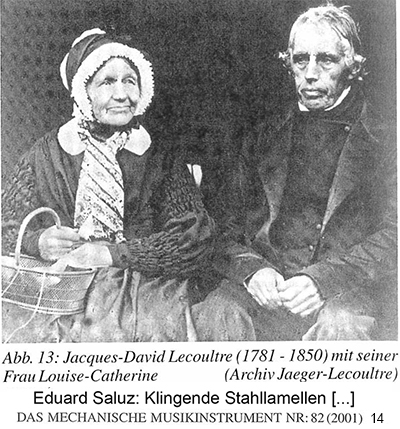
Werknummern: 6000–23000
Siehe ein Sektionalkammspielwerk und ein
weiteres Sektionalkammspielwerk
Jacques-David Lecoultre in Le Brassus, tätig 1829–1850, im Jahr 1814 der Erfinder des Einzelkammes, der sich jedoch erst ab 1820 durchsetzte
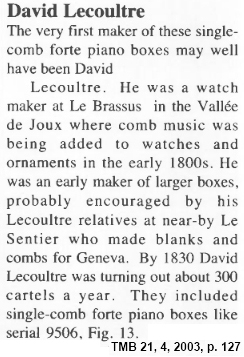
Lecoultre, David
Le Brassus, Switzerland, c. 1810 onwards. Excellent-quality key-wound musical boxes up to 1850. Also small movements. Said to have been the originator of the brass cylinder for musical boxes in place of the earlier platform movement.
(Ord-Hume, Music Box, 1980, p. 313)

Zu einer höheren Auflösung klicken
Rouage à Balancier

Hooked Teeth

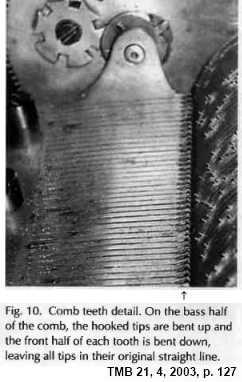
David Lecoultre & Son
Lecoultre, D., & Son
Le Brassus, Switzerland. As David Lecoultre until about 1860 when the brothers Lecoultre amalgamated. Makers of musical boxes who exhibited at the Great Exhibition in London in 1851.
(Ord-Hume, Music Box, 1980, p. 313)
Ami Lecoultre, Spielwerkmacher in den 1850er Jahren in St. Croix, danach in Lausanne
Mitglied der Jury der Nationalen Ausstellung in Zürich 1883
(Piguet 2004, p. 252-253)
From François Charles to Charles François Lecoultre: 1865–1871
Serials: mainly 35000–39000
Lecoultre, François Charles
Born in Le Chenit on 4 April 1801; died in Geneva, 8. January 1871. His father was a watchmaker named Louis Phillipe Samuel Lecoultre and his mother was Charlotte Piguet, the sister of Isaac Daniel Piguet. At the age of 20, he moved to Geneva and sought naturalisation as a Swiss. In 1827 he is listed as in charge of a musical-box manufactory and in 1828 joined the business of Henry David Golay. On the death of Golay he assumed control and finally, in the early 1840s, moved it to rue de Chantepoulet 39, where it remained for many years. François Charles Lecoultre did a great deal to foster the Geneva musical-box industry and, in his later years, he employed more than fifty workers. A frequent traveller to London, from where he established trading relations with India and China, he was a highly respected maker of quality musical boxes. In 1829, his brother Charles Philippe Lecoultre joined him for a few years from Le Chenit and finally moved to Geneva with his family in 1833. He died in Geneva in 1850. François Charles Lecoultre married twice. By his second wife, a girl from Geneva, he had a son, Charles François Lecoultre.
(Ord-Hume, Music Box, 1980, p. 314)
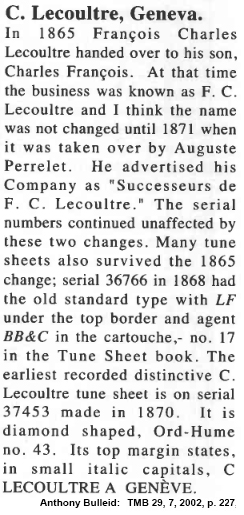

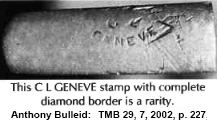
Lecoultre, Charles François
Son of Lecoultre, François Charles, born 18 August 1834; died 7. January 1914. He took over his father´s business in 1865 and moved it to rue des Alpes 12. He was responsible for a number of improvements in musical-box design and production, but about 1871 (according to Pierre Germain) he handed over the business to Perrelet, Auguste, under whose name it remained until Perrelet´s death in 1900. Meanwhile, Charles François Lecoultre had established contacts in South America and, having traded for some years with Hermanos Breyer of Calle Florida 49, Buenos Aires and its subsidiaries in Rosario and La Plata, he left the country in 1889 and tried to establish a musical-box industry in the Argentine Republic. He failed, but ran a repair shop until 1910, when he came back to Switzerland; he died four years later.
(Ord-Hume, Music Box, 1980, p. 314)

Diamond shaped tune sheets of C. Lecoultre ( ) )
Other tune sheets of C. Lecoultre ( ) )
F. C. Lecoultre (gegründet) / Lecoultre & Brechet
Siehe auch eine Spieldose der SAS-Auktion von 30. Nov. 2011
Siehe eine Bordüre einer Musiktafel, die mit vielleicht mit Lecoultre zusammenhängt und bitte auch diesen Link anzuklicken
Siehe eine Bordüre einer Musiktafel, die mit vielleicht mit Lecoultre zusammenhängt und bitte auch diesen Link anzuklicken

SPIELDOSEN
See also the chapter Music boxes of M. Bordier, F. Lecoultre, report: David Worrall
( )+( )+( )+( )+( )+( )+( )= )= Spieldosen / music boxes of the featured (main) composers' (Säulenheiligen-) Musiktafeln / tune sheets chapters 4/2+4/3+4/5+12/3=Total: Spieldosen / music boxes of the featured (main) composers' (Säulenheiligen-) Musiktafeln / tune sheets chapters 4/2+4/3+4/5+12/3=Total:
4/2: •RoMozard – MeyerHal•

 Spielwerke:
Nummer unbekannt;
329,
2753,
2814,
5895,
7447,
7580,
7720,
8268,
8553,
8594,
8954,
18294,
21109; 23666,
24093,
25876,
26627,
27740,
[Wechsel von Lecoultre & Brechet auf Lecoultre Frères]
28312,
28477,
29254,
32572,
35177,
35904,
36297,
36533,
39263,
44384 Spielwerke:
Nummer unbekannt;
329,
2753,
2814,
5895,
7447,
7580,
7720,
8268,
8553,
8594,
8954,
18294,
21109; 23666,
24093,
25876,
26627,
27740,
[Wechsel von Lecoultre & Brechet auf Lecoultre Frères]
28312,
28477,
29254,
32572,
35177,
35904,
36297,
36533,
39263,
44384
4/3: •Bollini [=Bellini]Her – AuberWe•
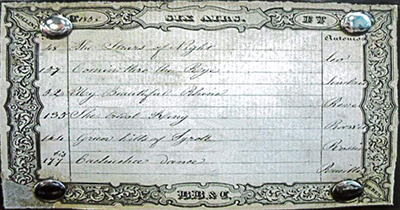
 Spielwerke:
2138,
2346,
2847,
8497,
11144 Spielwerke:
2138,
2346,
2847,
8497,
11144
4/5: •RosHal – MeyerAub•

 Spielwerke:
1979,
1979,
1979,
3537,
10920,
36766 und vielleicht zwei weitere hierhergehörige Werke mit der Seriennummer, eines mit der Seriennummer 11233 Spielwerke:
1979,
1979,
1979,
3537,
10920,
36766 und vielleicht zwei weitere hierhergehörige Werke mit der Seriennummer, eines mit der Seriennummer 11233
12/3: •BelMoRoWeMeyerFlot – VerDonSLabGSch•
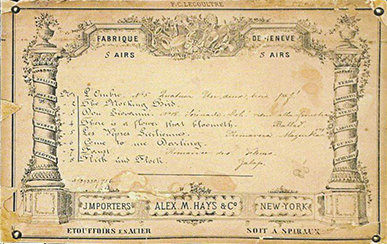
 Spielwerk: 39553 Spielwerk: 39553
(Wenn diese Angabe wirklich stimmt, ist es eben die berühmte Ausnahme von der Regel, oder aber diese Musiktafel ist eine spätere Zutat und damit ein Artefakt)
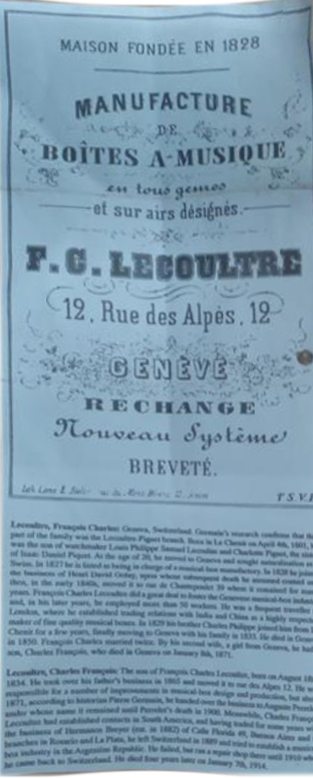
Firmeninformation in Schatulle Nr. 25981
Lecoultre-Granger
14/3/a: •HerHayVerMozard – AdamBerlDavidRo – BelAubWe – MeyerBoieBeet•
( ) )
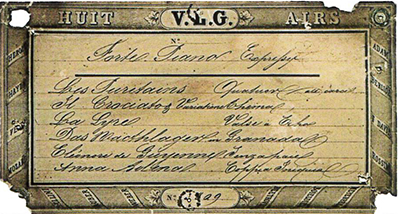
Spielwerk: 3809
Bulleid, Technology, p. 78 (Table 6, abridged)
Serial / year
7326 1831
11484 1835
21392 1843
26890 1854: bass engraved C. F. Lecoultre
29277 1847
36766 1867
37453 1869 Diamond shaped Geneva tune sheet
3493 1835
9325 1847
 Spielwerke von Lecoultre Spielwerke von Lecoultre
Perrelet: 1871–1890
Werknummern: 39000–49000

Zur Familiengeschichte
Charles Antoine LeCoultre, 1803 bis 1881, war Uhrmacher und Mitbegründer der Firmen LeCoultre und Jaeger-LeCoultre.
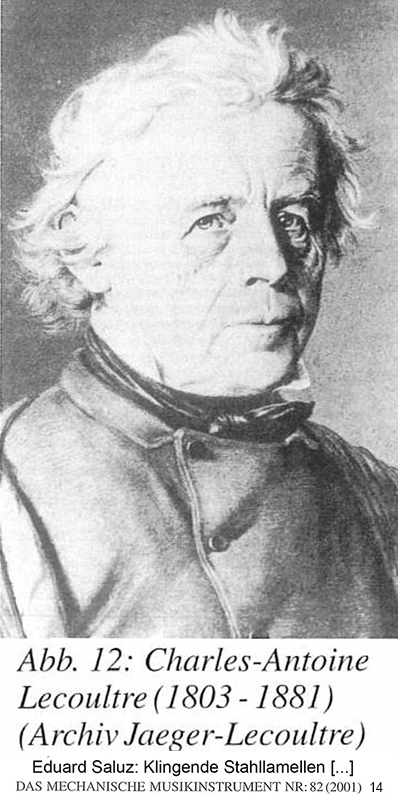
Charles-Antoine LeCoultre erlernte von seinem Vater Jacques-David LeCoultre das Handwerk des Messerschmieds, in dessen Werkstatt man sich auch mit der Veredelung von Stahl für die Uhrenherstellung befasste. Daneben war sein Vater auch Hersteller von Bestandteilen für Spieldosen.
Charles-Antoine L. ging nach Genf und lernte bei seinem Onkel François Louis Lecoutre das Uhrmacherhandwerk.
Ab 1829 fertigte er auch selbst Rasiermesser. 1830 firmierte er zusammen mit seinem Vater Antoine unter dem Namen Jacques David LeCoultre & Fils.
Charles-Antoine LeCoultre heiratete am 28. Juli 1831 in Le Sentier Zélie Julie Golay, die Tochter des Unruh-Fabrikanten Louis Samuel Golay, eine weit entfernt verwandte Cousine. Aus der Ehe entstammen acht Kinder, von denen drei Uhrmacher werden und dem Betrieb des Vaters beitraten: Elie, Paul und August Benjamin L.
1833 gründete Charles-Antoine L. gemeinsam mit seinem Bruder François Ulysse L. die Fabrik Antoine LeCoultre & Frère in Le Sentier im Vallée de Joux, aus der später die berühmte Manufaktur Jaeger-LeCoultre werden sollte.
Im Herbst 1833 kam es zum Bruch zwischen Vater und Sohn. Dieser richtete sich im Dachgeschoss des väterlichen Hauses eine eigene Werkstatt ein und stellte sechs Arbeiter ein. Das neu gegründete Unternehmen gedieh prächtig. Die Zahnräder waren so exakt, dass sie bei vielen Uhrenmanufakturen gekauft wurden.
Man begann zunächst mit der Herstellung von Maschinen, Werkzeugen (Lecoultre-Stichel), Zahnrädern und Trieben, und später (ab 1835) wurden komplette Rohwerke produziert.
Im Jahr 1853 schloss sich Charles-Antoine L. mit seinem Schwiegersohn, Jean Gallay, 1819 – 1861, zur Firma Antoine LeCoultre & Fils zusammen.
(Louise Augustine Marie Le Coultre, (1834-1893), hatte die Tochter von Charles-Antoine L., einen Arbeiter aus der Fabrik, einen Uhrmacher namens Jean Gallay, geheiratet).
Firma Antoine LeCoultre & Fils wurde ab etwa 1858 durch Gallay in ernsthafte finanzielle Schwierigkeiten gebracht. Nicht die Qualität der Produkte war die Ursache, sondern eine riskante Kundenstrategie und eine missglückte finanzielle Gebarung. In dieser Phase fand Charles-Antoine in Auguste Borgeaud einem Uhrmacher, Kaufmann und Buchhalter, einen neuen Partner. Diese neue Firma nannte man LeCoultre Borgeaud & Cie., deren Rohwerke mit der Beschriftung LCB gestanzt wurden. Mit dem Einstieg von drei Söhnen im Betrieb wurde die Firmierung in LeCoultre & Cie umbenannt und ab 1881, nach dem Tod von Charles-Antoine LeCoultre erneut in LeCoultre & Fils. (Le Coultre wurde eigentlich noch immer separat geschrieben). Ab 1899 hieß der Betrieb LeCoultre & Cie SA.
Charles-Antoine LeCoultre entwickelte sowohl Industriemaschinen als auch Präzisionsinstrumente, wie z. B. im Jahr 1844 das Millionometer, ein Instrument, mit dm man in millionstel Millimeter messen konnte, weiters 1847 den Bascule-Aufzug (Kronenaufzug mit Wippe) und zwanzig Jahre später sogar den „Remontoir a vue“.
Charles-Antoine LeCoultre verstarb am 26. April 1881. Sein Sohn Elie LeCoultre übernahm die Leitung der Firma.
(https://watch-wiki.org, http://wizard.webquests.ch/ch_industrielle.html?page=2336)
    
|


























